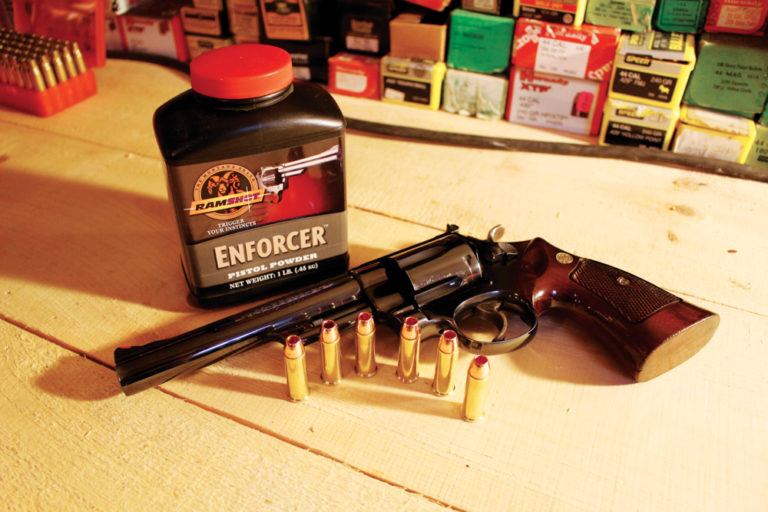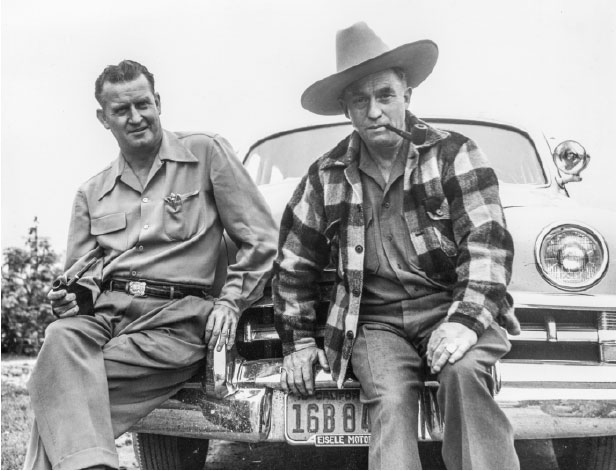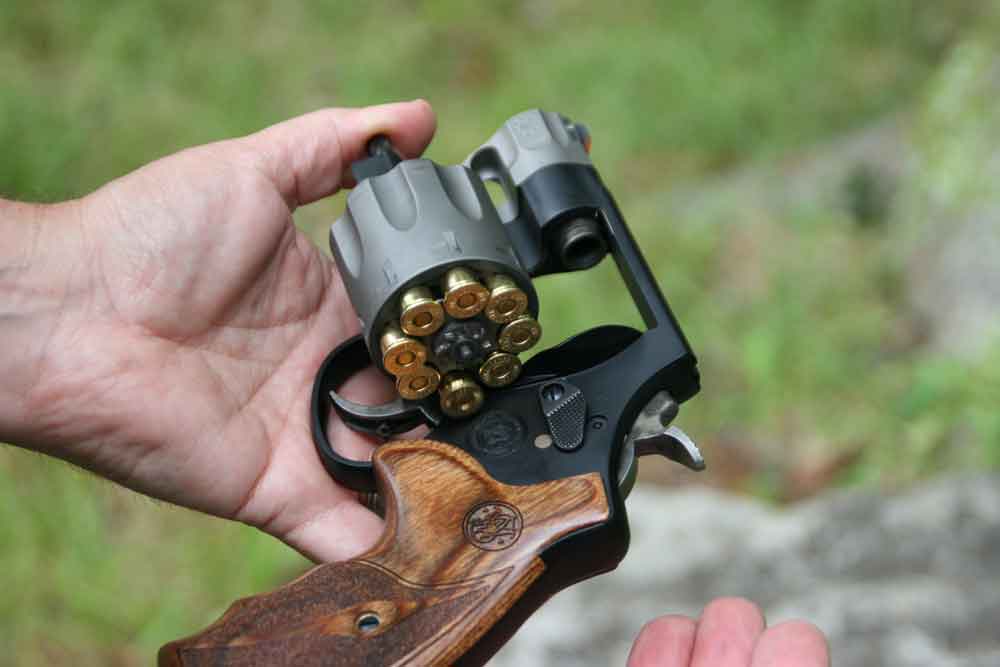
Elmer Keith was the key in the development of many cartridges, but it's the Ol' Cuss' work on handgun magnums that helped reshape the firearms world.
Keith was key in bringing some popular handgun magnums to the masses:
The gun world is full of personalities, both the genuine and the two-bit knockoff. Elmer Keith most certainly fell into the former and probably made the latter as jittery as lambs during docking season.

Typically pictured with six-shooters in his hands, a large Stetson on his head and a well-chewed cigar between his teeth, Keith seemed like the American Spirit come to life. But under his homespun exterior ticked a thinking man, particularly on the subject of guns. A fella doesn’t produce more than a half-century of articles for the top gun publications in the country and a mountain of books purely off of Western charm. At least they didn’t in Keith’s day.
The rancher and big game guide knew his stuff, even if he had to learn it first hand and blow the loading gate off a single-action Colt .45 in the process. And Keith innovated from this hard-won, sometimes dangerous knowledge. From the efficient Keith style bullet to a handsome and quick-drawing six-gun holster to advancing the sport of handgun hunting, modern shooters still owe this firearms wildcatter a debt of gratitude.
There was, however, one area where he perhaps exerted more influence than any other — cartridge development. A lover of big-bore firearms that slung big lead, fueled by big loads, Keith’s work revolutionized what we shoot today. And nowhere was his impact greater than on the handgun, magnum handguns. Would they exist today without him? Probably, but sans his hot loading and constant hounding of gun and ammunition companies they might have taken a spell longer to come to fruition and gain popularity.
So without further ado, here are the three handgun cartridges Elmer Keith helped innovate you need to know. Without out them and the Ol’ Cuss modern shooting wouldn’t have been the same.
.357 Magnum

Possibly the most popular high-velocity handgun cartridge to come down the pike was born, in part, from Elmer Keith’s pushing lead to its limits. The Ol’ Cuss didn’t bring the first magnum handgun cartridge to market in 1935; Major Douglas B. Wesson and Philip B. Sharpe get that credit. But Keith did plenty of hot-rodding the .357’s forerunner — the .38 Special — to help lay the groundwork.
Actually, he and Sharpe both pushed the Special to its redline separately with heavier bullets and bigger charges. And the time was ripe to take the cartridge to its ballistic limits. Smith & Wesson released its N-frame .38/44 revolvers in the early 1930s, engineered to weather the high pressure of hot .38 loads. For a short time there was a .38/44 cartridge, simply a .38 Special loaded to produce around 1,150 fps muzzle velocity. Sharpe and Keith took advantage of the beefed-up revolvers, cooking up rounds approaching 1,400 fps at the muzzle with a 158-grain bullet.
Keith’s interest in the souped-up .38 eventually waned when he became enamored with developing what became his baby — the .44 Magnum. But Sharpe and Wesson both drew upon his work to finalizing the legendary .357 Magnum.
Slightly longer than the .38 Special, so it's not accidentally loaded the lighter-framed revolver, the magnum today is capable of pushing a 180-grain jacketed hollow point 1,550 fps. The S&W Model 27 was the first gun chambered for the hard-hitting .357, but it made its way into some all-time classics, including the coveted Colt Python.
.44 Remington Magnum

The big .44 was Elmer Keith’s magnum opus. Able to kill truck engines at close range and deer at 600 yards graveyard dead, the .44 Magnum is the hallmark of handgun power. Only in the last quarter century or so has it been dethroned as the world’s most powerful handgun cartridge.
Keith had to preach like a minister before end days to convince gun and ammunition companies his hot .44 Special was viable, not just a blown off hand waiting to happen. What had the manufacturers edgy was Keith’s test revolver. For around 15 years, he sent his heavy .44 bullets with ample loads screaming to the tune of 1,200 fps out of a Smith & Wesson Triple Lock. Despite Keith never running into a hitch, S&W was nervy about the hot load-revolver combination. In their eyes, it was an accident waiting to happen. After all, it was designed and manufactured before some key metallurgical advancements.
Ever the innovator, the cowboy had a simple solution — build a modern gun to wrap around his cartridge. Smith & Wesson relented and in 1955 and whipped up the first of what would become a jewel of the revolver world — the Model 29. Remington supplied the factory ammo for Keith’s cannon — a hair longer than the .44 Special ensuring it didn’t make its way into a lighter-framed revolver.
The .44 Magnum and Model 29 were an instant sensation, though many made their way back to gun stores when their owners discovered they kicked like a maladjusted mule. This facet of the magnum also smashes popular Hollywood hoopla — the cartridge was never big with law enforcement, outside of “Dirty” Harry Callahan. The 29 is a lot of gun to strap to a duty belt, and the .44 bucks like rough stock; not the stuff that keeps you in the black when qualifying.
But with the ability to punt a factory-loaded, 210-grain jacketed hollow point 1,494 fps at the muzzle, it’s still a cherished. Even with more powerful options available, the .44 Magnum remains a top choice of handgun hunters the world around.
.41 Remington Magnum

The .41 Magnum’s pedigree should have gotten it into the finest chambers around. But it never really got out of the shadows of Elmer Keith’s other projects.
Developed by Keith, with input from marine, lawman and gun writer Bill Jordan, the .41 was supposed to be a ‘Mama Bear’ cartridge tailored for law enforcement. More stopping power than a .357 Magnum, easier to shoot than the .44 Magnum. Trends of the days, however, sent the .41 into semi-obscurity.
Early on, Keith advocated a milder .41 Special to fill the .357’s terminal ballistics cracks, while still keeping the gun manageable, particularly during rapid fire. The issue was, by the time Smith & Wesson and Remington listened to Keith and Jordan it was the early 1960s and the era of hard-hitting, wrist-snapping magnums was in full swing.
In turn, the market morphed Keith’s .41 Special concept into the .41 Magnum reality. When S&W’s .41 Magnum Model 58 was released in 1964, its ‘light’ police load was a 210-grain semi-wadcutter that escaped the muzzle at 1,150 fps. Overkill, plain and simple, and most law enforcement agencies saw it that way too. That’s quite a bit of big iron in the hand of an officer used to a pussycat like the .38 Special.
All was not lost for the .41 Magnum, however. While it never earned anything like the .44 Magnum’s ticker-tape parade, it proved itself a competent hunting round. It is big medicine on the likes of deer, bear and other medium-sized game, and it offers some advantages over its bigger brother, namely a flatter trajectory and less recoil.
Even with a dedicated following today, Keith’s black sheep magnum still faces hurdles. Factory loads are as scarce as July snowflakes, which makes the round fitter for handloader types. But depending on whom you ask that’s not necessarily a bad thing.

Next Step: Get your FREE Printable Target Pack
Enhance your shooting precision with our 62 MOA Targets, perfect for rifles and handguns. Crafted in collaboration with Storm Tactical for accuracy and versatility.
Subscribe to the Gun Digest email newsletter and get your downloadable target pack sent straight to your inbox. Stay updated with the latest firearms info in the industry.

![Best Concealed Carry Guns In 2025 [Field Tested] Wilson Combat EDC X9S 1](https://gundigest.com/wp-content/uploads/Wilson-Combat-EDC-X9S-1-324x160.jpg)


![Best 9mm Carbine: Affordable PCCs [Tested] Ruger Carbine Shooting](https://gundigest.com/wp-content/uploads/Ruger-Carbine-Shooting-100x70.jpg)
![Best AR-15: Top Options Available Today [Field Tested] Harrington and Richardson PSA XM177E2 feature](https://gundigest.com/wp-content/uploads/Harrington-and-Richardson-PSA-XM177E2-feature-100x70.jpg)
